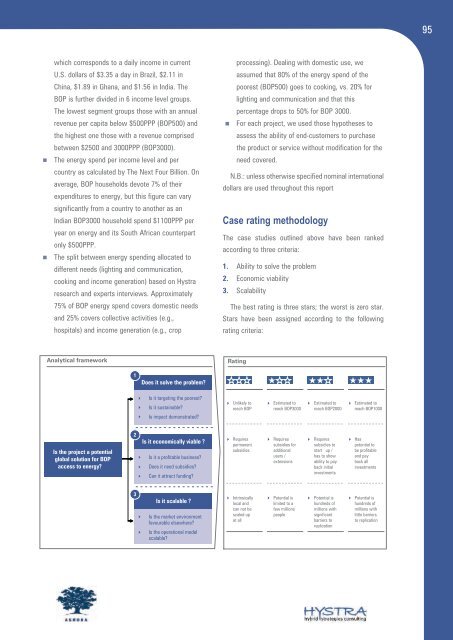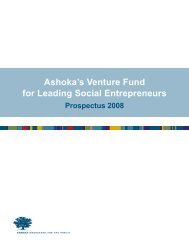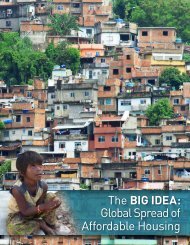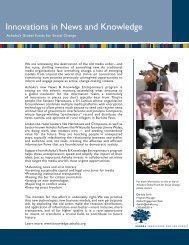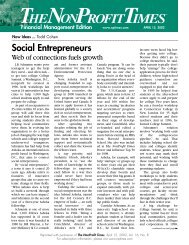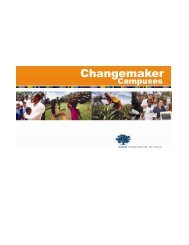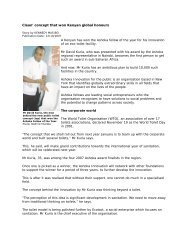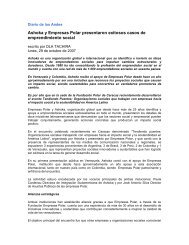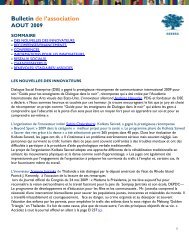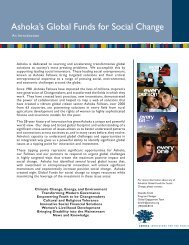Access to Energy for the Base of the - Ashoka
Access to Energy for the Base of the - Ashoka
Access to Energy for the Base of the - Ashoka
You also want an ePaper? Increase the reach of your titles
YUMPU automatically turns print PDFs into web optimized ePapers that Google loves.
which corresponds <strong>to</strong> a daily income in current<br />
U.S. dollars <strong>of</strong> $3.35 a day in Brazil, $2.11 in<br />
China, $1.89 in Ghana, and $1.56 in India. The<br />
BOP is fur<strong>the</strong>r divided in 6 income level groups.<br />
The lowest segment groups those with an annual<br />
revenue per capita below $500PPP (BOP500) and<br />
<strong>the</strong> highest one those with a revenue comprised<br />
between $2500 and 3000PPP (BOP3000).<br />
� The energy spend per income level and per<br />
country as calculated by The Next Four Billion. On<br />
average, BOP households devote 7% <strong>of</strong> <strong>the</strong>ir<br />
expenditures <strong>to</strong> energy, but this figure can vary<br />
significantly from a country <strong>to</strong> ano<strong>the</strong>r as an<br />
Indian BOP3000 household spend $1100PPP per<br />
year on energy and its South African counterpart<br />
only $500PPP.<br />
� The split between energy spending allocated <strong>to</strong><br />
different needs (lighting and communication,<br />
cooking and income generation) based on Hystra<br />
research and experts interviews. Approximately<br />
75% <strong>of</strong> BOP energy spend covers domestic needs<br />
and 25% covers collective activities (e.g.,<br />
hospitals) and income generation (e.g., crop<br />
Analytical framework<br />
Is <strong>the</strong> project a potential<br />
global solution <strong>for</strong> BOP<br />
access <strong>to</strong> energy?<br />
1<br />
2<br />
3<br />
Does it solve <strong>the</strong> problem?<br />
Is it targeting <strong>the</strong> poorest?<br />
Is it sustainable?<br />
Is impact demonstrated?<br />
Is it economically viable ?<br />
Is it a pr<strong>of</strong>itable business?<br />
Does it need subsidies?<br />
Can it attract funding?<br />
Is it scalable ?<br />
Is <strong>the</strong> market environment<br />
favourable elsewhere?<br />
Is <strong>the</strong> operational model<br />
scalable?<br />
processing). Dealing with domestic use, we<br />
assumed that 80% <strong>of</strong> <strong>the</strong> energy spend <strong>of</strong> <strong>the</strong><br />
poorest (BOP500) goes <strong>to</strong> cooking, vs. 20% <strong>for</strong><br />
lighting and communication and that this<br />
percentage drops <strong>to</strong> 50% <strong>for</strong> BOP 3000.<br />
� For each project, we used those hypo<strong>the</strong>ses <strong>to</strong><br />
assess <strong>the</strong> ability <strong>of</strong> end-cus<strong>to</strong>mers <strong>to</strong> purchase<br />
<strong>the</strong> product or service without modification <strong>for</strong> <strong>the</strong><br />
need covered.<br />
N.B.: unless o<strong>the</strong>rwise specified nominal international<br />
dollars are used throughout this report<br />
Case rating methodology<br />
The case studies outlined above have been ranked<br />
according <strong>to</strong> three criteria:<br />
1. Ability <strong>to</strong> solve <strong>the</strong> problem<br />
2. Economic viability<br />
3. Scalability<br />
The best rating is three stars; <strong>the</strong> worst is zero star.<br />
Stars have been assigned according <strong>to</strong> <strong>the</strong> following<br />
rating criteria:<br />
Rating<br />
Unlikely <strong>to</strong><br />
reach BOP<br />
Requires<br />
permanent<br />
subsidies<br />
Intrinsically<br />
local and<br />
can not be<br />
scaled-up<br />
at all<br />
Estimated <strong>to</strong><br />
reach BOP3000<br />
Requires<br />
subsidies <strong>for</strong><br />
additional<br />
users /<br />
extensions<br />
Potential is<br />
limited <strong>to</strong> a<br />
few millions<br />
people<br />
Estimated <strong>to</strong><br />
reach BOP2000<br />
Requires<br />
subsidies <strong>to</strong><br />
start up /<br />
has <strong>to</strong> show<br />
ability <strong>to</strong> pay<br />
back initial<br />
investments<br />
Potential is<br />
hundreds <strong>of</strong><br />
millions with<br />
significant<br />
barriers <strong>to</strong><br />
replication<br />
Estimated <strong>to</strong><br />
reach BOP1000<br />
Has<br />
potential <strong>to</strong><br />
be pr<strong>of</strong>itable<br />
and pay<br />
back all<br />
investments<br />
Potential is<br />
hundreds <strong>of</strong><br />
millions with<br />
little barriers<br />
<strong>to</strong> replication<br />
95


